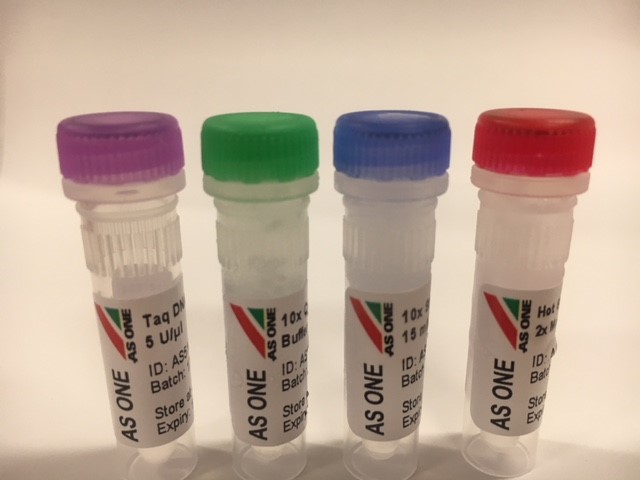Description
Red-Taq DNA Polymerase
10X Ammonium Buffer
10X Standard Buffer
5 units/µL
Cat. No. |
Units |
10X Ammonium Buffer |
10X Standard Buffer |
MgCl225 mM |
AO204103 |
500 |
1.5 mL |
1.5 mL |
1.5 mL |
AO204104 |
1,000 |
2 x 1.5 mL |
2 x 1.5 mL |
2 x 1.5 mL |
AO204106 |
2,500 |
4 x 1.5 mL |
4 x 1.5 mL |
4 x 1.5 mL |
AO204107 |
5,000 |
3 x 5.0 mL |
3 x 5.0 mL |
3 x 5.0 mL |
AO204108 |
10,000 |
6 x 5.0 mL |
6 x 5.0 mL |
6 x 5.0 mL |
AO204109 |
20,000 |
8 x 5.0 mL |
8 x 5.0 mL |
8 x 5.0 mL |
Store at -20°C. For in-vitro laboratory use only
General Description
AS ONE Red-Taq DNA Polymerase is a thermostable recombinant DNA polymerase, which exhibits very high activity in primer extension and other molecular biology applications. R-Taq contains a red dye which provides easy and quick identification of reactions to which enzyme was added and allows confirmation of complete mixing. The inert dye has no effect on downstream processes. Red-Taq is added directly to the reaction mix and is used in the same manner as standard Taq DNA Polymerase.
AS ONE Red-Taq DNA Polymerase has both a 5’®3′ DNA polymerase and a 5’®3′ exonuclease activity. The enzyme lacks a 3’®5′ exonuclease activity. R-Taq DNA Polymerase leaves an A¢ overhang, which makes the enzyme ideal for TA cloning.
Key Features
- High performance thermostable DNA polymerase
- Red dye identifies tubes which contain enzyme and confirms complete mixing of reagents
- Leaves an A¢ overhang
Unit Definition
One unit is defined as the amount that incorporates 10 nmoles of dNTPs into acid-precipitable form in 30 minutes at 72°C under standard assay conditions.
Storage Buffer
Enzyme is supplied in 20 mM Tris-HCl pH 8.3, 100 mM KCl, 0.1 mM EDTA, 1 mM DTT, inert dye, 0.5 % TweenÒ 20, 0.5% NP40, 50% glycerol.
10X Ammonium Reaction Buffer
Tris-HCl pH 8.5, (NH4)2S04, 15 mM MgCl2, 1% Tween 20
10X Standard Reaction Buffer
100mM Tris-HCI pH 8.3, 500mM KCl, 15mM MgCl₂, 1% Triton X-100
Quality Control
Endonuclease, exonuclease and priming activities are not detected after 3 hours incubation of 1 mg of pUC19 plasmid DNA and 0.5 µg EcoRI digested lambda phage DNA at 72°C in the presence of 40 units of Red Taq DNA Polymerase.
Suggested Protocol using R-Taq DNA Polymerase
This protocol serves as a guideline only. Optimal reaction conditions may vary and must be individually determined.
- In some applications, more than 1.5mM MgCl2 is needed for the best results. For this reason, 25 mM MgCl2 is included with the kit.
- Thaw desired 10X Buffer, dNTP mix, and primer solutions. It is important to mix the solutions completely before use to avoid localized concentrations of salts.
- Prepare a master mix according to Table 1. The master mix typically contains all the components needed for extension except the template DNA.
Table 1. Reaction components (master mix & template DNA)
Component |
Vol./reaction | Final Conc. |
| 10X Buffer | 5 µL | 1X |
| 25 mM MgCl2 | 0 µL (0-7 µL) | 1.5 mM (1.5–5 mM) |
| dNTP mix
(12.5 mM of each) |
0.8 µL | 0.2 mM of
each dNTP |
| Primer A | 1 µL (0.5-5 µL) | 0.2 µM (0.1–1.0 µM) |
| Primer B | 1 µL (0.5-5 µL) | 0.2 µM (0.1–1.0 µM) |
| R-Taq DNA Polymerase | 0.6 µL (0.2–1 µL) | 3 units (1–5 units) |
| Template DNA | Variable | Genomic DNA 50 ng (10-500 ng)
Plasmid DNA 0.5 ng (0.1-1 ng) Bacterial DNA 5 ng (1-10 ng) |
| Distilled Water | Variable | – – – – |
| TOTAL volume | 50 µL | – – – – |
Table 2. MgCl2 concentration in a 50 mL reaction
| Final MgCl2 conc. in reaction (mM) | 1.5 | 2.0 | 2.5 | 3.0 | 3.5 | 4.0 | 4.5 |
| Additional Volume of 25 mM MgCl2
per rxn (µL): |
0 | 1 | 2 | 3 | 4 | 5 | 6 |
Table 2 provides the volume of 25 mM MgCl2 to add to the master mix if a certain MgCl2 concentration is required.
- Mix the master mix thoroughly and dispense appropriate volumes into reaction tubes. Mix gently (e.g., by pipetting) the master mix up and down a few times.
- Add template DNA (0.1–0.5 mg/reaction) to the individual tubes containing the master mix.
- Program the thermal cycler according to the manufacturer’s instructions.
For maximum yield and specificity, temperatures and cycling times should be optimized for each new template target or primer pair.
- Place the tubes in the thermal cycler and start the reaction.
- After primer extension, load 5-10 mL of a 50 mL reaction directly on an agarose gel for analysis.
Three- step PCR Program:
| Cycles | Duration of Cycles | Temperature |
| 1 | 2-5 minutesa | 95°C |
| 25-35 | 20-30 secondsb
20-40 secondsc 30 secondsd |
95°C
50-65°C 72°C |
| 1 | 5 minutese | 72°C |
a Initial denaturation step. Optional, but recommended for genomic DNA
b Denaturation step: Heating the DNA template disrupts the hydrogen bonds yielding ssDNA.
c Annealing step: Primers anneal to ssDNA template. Typically annealing temperature is 3-5°C below the Tm of the primers.
d Extension/elongation step: R-Taq DNA polymerase synthesizes a new DNA strand complementary to the DNA template. Extension time depends on length of DNA fragment to be amplified. At optimum temperature the DNA polymerase will polymerize 1000 bases per minute.
e Final elongation step: After the last PCR cycle to ensure that any remaining ssDNA is fully extended.



Reviews
There are no reviews yet.